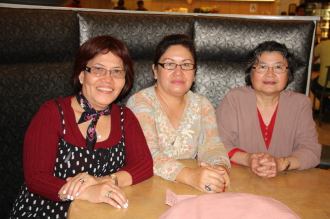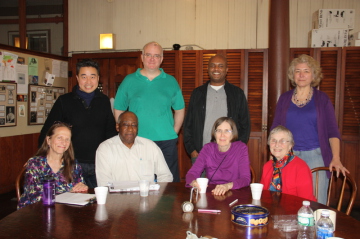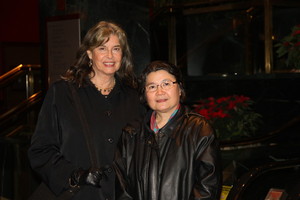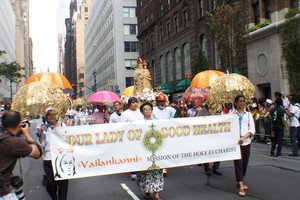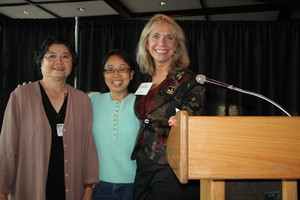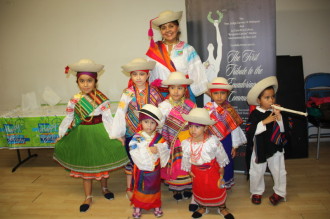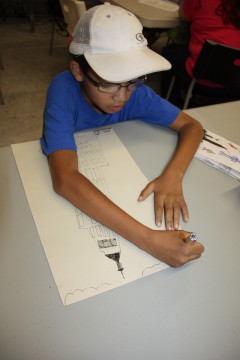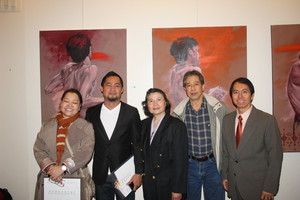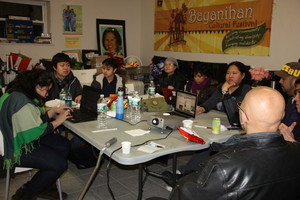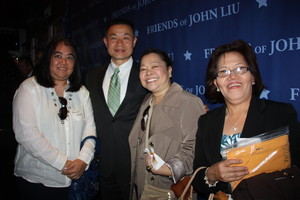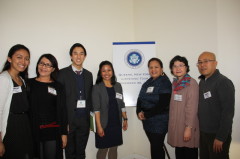A TRIAD of NONPROFIT Organizational Model
Philippine Community Center Services for Aging
Divine Child Foundation
SHARED MISSION, SHARED GOVERNANCE, SHARED RESOURCES
By the staff, Board members, volunteers and other stakeholders.
Purpose:The purpose ofThe Nursing Office Foundation, Inc. /TNO Foundation, Inc. is to transform healthcare through nursing leadership utilizing “The Nurse is IN: A Model for Affordable Community and Public Health Delivery System.”
Background:A Community Health Survey in 1994-1998, entitled "Challenging the Heath Care Apartheid," has found that " recognizing ethno-cultural barriers is an important step in reforming and democratizing the healthcare system," and that "the irony (of widening disparity) becomes more glaring because the leading killers of people of color have been attributed to diseases that are largely preventable." The study used NYS DOH concepts of Access, Cultural Competency, and Quality of Care. The findings established factors critical to health outcomes: lack of health insurance, education level, and poverty; lack of culturally competent services; lack of ethnic minority health care providers; low utilization of care, health promotion, and disease prevention services.
TNO Foundation, Inc. seeks to "break the health care apartheid" by expanding roles and functions of Nurses --- making them catalysts for change, thereby shaping the future of Nursing and Health care.
TNO Foundation, Inc. envisions an environment of "transcultural nursing" articulated by the Leininger School in the 1970s, promoting culturally sensitive nursing care that bridges differences between cultural belief systems of caregiver and client, addressing issues of disparity and inequity, and countering the ineffectiveness of the current system in the multi-cultural structures of our communities.
TNO Foundation, Inc., seeks to utilize the multiple roles of Nurses as trainers, educators, healers, innovators, leaders and engaging them as Communicators, Bridges, Facilitators, Connectors to reach invisible, voiceless, uninsured, high-risk persons with little or no access to culturally competent health care services, through Community Healthcare Workers (CHWs) chosen from and trained to work with their own people.
TNO Foundation, Inc., will build Basic Community Living Infrastructures (BCLI)where natural holistic solutions based on socio-cultural & economic values of individuals and families, are practiced in environments that are collaborative, participative, culturally sensitive, and integrative within a Community Health Center, run by the community, for the community.
TNO Foundation, Inc., seeks to ease current nursing shortages by maximizing their roles in health care; create more jobs; reduce unemployment; and reduce health care costs through effective resource use, through delivery programs, such as, Capacity-Building & Training, Health Education & Promotion, Advocacy & Political Action, Outreach & Network Development, Research, Sustainability, and Effective Communications. Strategies include: supporting Nursing Office venues in various physical offices, Internet-based websites, Referral sites, and Social Mediasites; designing effective Health Fairs; enhancing Nurses' leadership skills; and utilizing Allied health and healthcare workers in forging community partnerships.
"The Nurse is In: How May We Help You?"
EIGHT KEY AREAS OF NONPROFIT EXCELLENCE
- Overall management focus on results
- Governance structure that moves the organization forward
- Strong, transparent and accountable financial management
- Diversity and culturally competent organizational practices
- Enlightened use of human resources
- Appropriate and reliable information technology (IT) systems
- Regular and effective communications & use of communications technology
- Effective, ethical fundraising and resource development
November 18, 2015 Contact: Zac Roy, zac@anatgerstein.com, 917-822-7203
Three Exceptional New York Nonprofits Win 2015 Nonprofit Excellence Awards –
New York Common Pantry wins the Gold Prize for Overall Management Excellence – – America Needs You and BRC win the Silver Prize and Bronze Prize for Management Excellence, respectively – (New York, NY) – Three nonprofit groups have been chosen as winners of the 2015 New York Community Trust Nonprofit Excellence Awards, which include a total of $60,000 in prizes as well as tuition scholarships for the Columbia Business School Executive Education Programs in Social Enterprise. The announcement of the three winning organizations – New York Common Pantry, America Needs You and BRC – was made by the Nonprofit Coordinating Committee of New York (NPCC), which created and manages the nine-year-old Awards program. New York Common Pantry won the Gold Prize for Overall Management Excellence. America Needs You and BRC won the Silver Prize and Bronze Prize for Management Excellence, respectively.
The prizes were awarded today at a best practices workshop, Awards presentation and reception held at CUNY Graduate Center in Manhattan. A selection committee of 34 nonprofit management experts chose the three winners from a group of six finalists – which were previously selected from among 10 semifinalists – following an intensive application and vetting process that identifies excellent and replicable management practices among nonprofits in New York City, Long Island and Westchester. New York Common Pantry is dedicated to reducing hunger throughout New York City while promoting dignity and self-sufficiency. America Needs You fights for economic mobility for ambitious, first-generation college students by providing transformative mentorship and intensive career development. BRC helps people reclaim lives lost by restoring hope and dignity and offering opportunities for health and self-sufficiency. “We are thrilled to honor these three outstanding organizations with this year’s Awards,” said Sharon Stapel, President of NPCC. “Through exemplary management practices, these nonprofits achieve incredible results for the people and causes they serve.”
“These groups have demonstrated exceptional management practices that should inspire the more than 40,000 nonprofits in New York City and its suburbs,” said Lorie Slutsky, President of The New York Community Trust, the sponsor of the award and one of the region’s leading funders of nonprofits. “We celebrate all of the 2015 Award applicants, especially the three winning organizations, which represent the best of our sector,” said Ronna Brown, President of Philanthropy New York, the regional association of grantmakers representing the interests of over 280 of the most prominent private, corporate and community foundations across the region. “We were out in force at the Awards ceremony because it was such a great opportunity for the entire sector to come together and learn from these remarkable organizations.” "To be recognized as a leader in our sector by The New York Community Trust Nonprofit Excellence Awards is an honor and we are thrilled to be chosen as one of the three winning nonprofits for the 2015 award,” said Stephen Grimaldi, Executive Director of New York Common Pantry. “As we continue to expand our work, New York Common Pantry remains steadfast in our mission to continue to improve the lives New Yorkers in need by providing dignity and self-sufficiency and determined to maintain our level of excellence." “America Needs You is deeply honored to be a 2015 winner of The New York Community Trust Nonprofit Excellence Awards,” said Kimberly A. Harris, CEO of America Needs You.
“We are eager to share our management strategies and best practices and to learn from our peers, as we continue our fight for economic mobility for first-generation college students.” “All of us at BRC are honored to be recognized as a medal-winning finalist in this year’s Nonprofit Excellence Awards,” said Muzzy Rosenblatt, Executive Director of BRC. “BRC is proud that our effort and success at achieving management excellence is being recognized by leaders in our philanthropic community, who rightly set the bar high for what nonprofits should and do achieve. BRC uses the best management practices to provide solutions to homelessness that are not only caring, they are effective, and we are grateful for the recognition.” The Excellence Awards program has attracted more than 685 applicants from across the city and its suburbs in its first nine years. The Awards recognize outstanding management practices in eight key performance areas identified by thousands of nonprofit leaders across the country. The eight areas of excellence are: management focus on results; strong governance; excellent financial management; diversity and culturally competent organizational practices; enlightened human resources; model IT practices; effective communications; and, exemplary fundraising and resource development.
NPCC created the Nonprofit Excellence Awards in 2007 and serves as the program’s tax-exempt manager, in collaboration with The New York Community Trust and Philanthropy New York. WNYC sponsors the program, which is also supported by The Clark Foundation, Ford Foundation, RSM US LLP, and Columbia Business School Executive Education Programs in Social Enterprise. More about the Nonprofit Excellence Awards, including the Awards’ guiding document, Eight Key Areas of Nonprofit Excellence; past winners; funders; and Selection Committee members, is available at www.npccny.org/info/awards.htm. # # # The Nonprofit Coordinating Committee of New York (NPCC) serves as the voice and information source for New York nonprofits. An umbrella organization representing and serving over 1,400 member nonprofit 501(c)(3) organizations throughout New York City, Long Island, and Westchester, NPCC is the largest such organization in the New York City area. It represents all types of nonprofits on sector-wide issues. Established in 1984, NPCC informs and connects nonprofit leaders, saves nonprofits money, helps them manage and govern themselves better, and protects and strengthens the entire nonprofit community’s relations with all levels of government. (www.npccny.org)
Since 1924, The New York Community Trust has been the home of charitable New Yorkers who share a passion for the City and the suburbs—and who are committed to improving them. The Trust supports an array of effective nonprofits that help make the City a vital and secure place to live, learn, work and play, while building permanent resources for the future. The New York Community Trust ended 2014 with assets of $2.6 billion in more than 2,000 charitable funds, and made grants totaling $165 million. The Trust welcomes new donors. (www.nycommunitytrust.org) Created as a nonprofit organization in 1979 by New York City-based foundations, Philanthropy New York’s primary mission is to support its members’ work to serve the public good. Philanthropy New York began as the New York Regional Association of Grantmakers (NYRAG). Philanthropy New York is the principal professional community of approximately 285 private, corporate, family and public grantmaking organizations based in the New York City region, and provides a broad range of services to over 3,500 individual philanthropic professionals and trustees of those organizations.
Taken together, PNY members provide support totaling over $7 billion each year to thousands of nonprofit organizations located in New York and around the world, which in turn focus on an almost endless range of issues and concerns. PNY fosters educational conversations between grantmakers and public officials, and this in turn helps inform policymakers about the important role the philanthropic community plays in our region and beyond. PNY offers policy-focused programs and convenings so members can exchange information about policy engagement and develop public/private partnerships with policymakers designed to achieve common goals. PNY is also the publisher of the New York PhilanthroPost, a source for aggregated news and original content focused on the New York region’s philanthropic and nonprofit sectors launched in June 2014. (www.philanthropynewyork.org)
On
November 18th, NPCC, The New York Community Trust, and Philanthropy New York announced the three winners for the 2015 New York Community Trust Nonprofit Excellence Awards.
The organizations range in size, budget, and age. Founded in 2006, America Needs You is the smallest with a budget of $3.2 million and 20 full time staff members; ANY is the youngest organization to
win this award. Founded in 1971, BRC is the oldest and largest with a budget of $67 million and 773 full time employees. New York Common Pantry has a budget of $5 million, 39 full time staff, and
over 14,400 volunteers.
The winners were selected from a pool of 56 applicants by the program's 34-member expert
Selection Committee for their outstanding management, focusing on Eight Key Areas of Nonprofit Excellence. Click here to read the press release.
ABOUT THE WINNING ORGANIZATIONS:
- Gold Prize Winner: New York Common Pantry is dedicated to reducing hunger throughout New York City while promoting dignity and self-sufficiency. Read about NYCP's Examples of Excellence.
- Silver Prize Winner: America Needs You fights for economic mobility for ambitious, first-generation college students by providing transformative mentorship and intensive career development. Read about ANY's Examples of Excellence.
- Bronze Prize Winner: BRC helps people reclaim lives lost by restoring hope and dignity and offering opportunities for health and self-sufficiency.Read about BRC's Examples of Excellence.
These winners were honored at an Awards Presentation and Best Practices Workshop on November 18th. The Best Practices Workshop included the executive director and a board member from each of the winning organizations and was moderated by Stephanie Thomas, President of Stetwin Consulting and NPCC Board Member.
Now in its ninth year, the Awards program recognizes outstanding management practices and educates nonprofit managers and board leaders throughout New York's nonprofit community about excellent management practices.
____________________________________________________________________________
The Awards program is open to all 501(c)3 nonprofits based in New York City, Long Island and Westchester. To read more about the 2015 New York Community Trust Nonprofit Excellence Awards program, please visit: http://npexcellence.fcny.org.
Examples of Excellence Presented at 2015 Best Practices Workshop New York Common Pantry www.nycommonpantry.org
New York Common Pantry is dedicated to reducing hunger throughout New York City while promoting dignity and self-sufficiency. Year Founded: 1980 ⏐Budget: $5,021,817⏐FT Staff: 39 ⏐PT Staff: 8⏐Volunteers: 14,423 ⏐Board Members: 22 Executive Director: Stephen Grimaldi ⏐Board Chair: Michael Fitzsimons, Chairman and CEO, DeskNet
Overall Management Focus on Results
• Strategic planning process grounded by an agency assessment – and led to programmatic and organizational changes
• Obtain continual customer feedback through staff engagement with participants and an annual Satisfaction Survey o Feedback and survey results inform management of services and help maintain a positive culture of customer service for clients
• Four management reports are regularly prepared and shared internally and with key funders o Return on Investment report, case management tracking, monthly financial statements, and Frequency Report
• Clearly use data evaluations to improve programs, and continue to analyze data to make further improvements (e.g. Choice Pantry and Live Healthy! programs) and increase efficiencies o Innovative integration of technology and outcomes to enhance services to clients o Philosophy that good data in equals good data out
• Expansion to new sites is being done with a strategic eye towards what has worked in the past
Governance Structure that Moves the Organization Forward
• Volunteer spirit permeates the board culture – board offers hands-on help in programs at the Pantry
• Purposeful and deliberate process of board strengthening and restructuring as outlined in the strategic plan o Reducing the number of board members o Regular assessment of performance o Increasing give/get expectations o Creating an Advisory Council to maintain engagement of those unable to meet give/get requirement
• Board Nominating Committee uses written rubric of required and preferred qualifications to guide how board candidates are considered
• Developed a rigorous onboarding and engagement program for new and existing board members
• Board chair holds the position for 3 years and succession planning begins mid-term to identify potential successors
• Executive Director submits self-evaluation and board reviews progress using a tool based on seven key management areas
Strong, Transparent and Accountable Financial Management
• Six months of reserves, planning to increase to one year
• Conservative and strategic approach to program expansion – decisions start at the service level
• Integrated accounting and fundraising database allows tracking and review of donations and expenses
• Financial health assessed by asking 3 key questions: o Does the organization have the resources it needs to pursue its mission? o Does the organization enjoy continued support from its community? o Does the organization do everything possible to steward its resources and assure appropriate use? NYCP: Examples of Excellence - 2
Diversity and Culturally Competent Organizational Practices
• Staff relatively diverse and reflective of population served o Hiring focuses on diversity and language to ensure participants feel comfortable and can be served o Responsive to changing client demographics (e.g. hired a Chinese-speaking case manager to address growth of Chinese client base)
• Strong gender diversity on board; actively working on improving board’s ethnic and racial diversity
• Staff are trained to be sensitive to ethnic, racial, cultural, gender, sexual orientation, religious and immigrant related issues; all front-line staff complete “Working with Diverse Populations” training course; senior staff, volunteer associate, and board vice-chair are also trained on diversity
• Committed to offering culturally sensitive food choices Enlightened Use of Human Resources
• Foster leadership by focusing on “three P’s” o Prepare: staff are encouraged to take on responsibilities and initiatives, and seek professional development o Predict: anticipate vacancies by conducting regular position assessments o Promote: clear focus on promoting from within
• Formal job descriptions are provided for all staff and are followed up with regular supervision and feedback sessions, including individual, departmental, and all-staff meetings, all part of an extensive annual review process
• Decentralization of leadership/shared leadership model helps prepare for planned and unplanned succession needs o Creation of Deputy Executive Director position and three additional Director-level positions
• Annual staff appreciation breakfast where board waits on staff; annual volunteer appreciation events
Appropriate and Reliable Information Technology Systems
• Implementation of Choice Pantry model for online ordering has led to cost savings and encourages pantry members to become active participants in their food selection
• Share database models with partnering organizations to improve overall sector output o Data has helped influence broader community of food providers
• Benefits tracker tool records results of screening by case managers and shows what benefits are available to individuals o Tool also shows benefit saturation level over time to help determine adequate staffing
• Expanded web-based software to include a new mobile services program, allowing NYCP’s food and benefits system to be replicated by other providers in the area
Regular and Effective Communications and Use of Communications Technology
• Rebranding effort has been very successful, leading to media placements and new individual and corporate donors
• Communications driven by thorough data collection and a commitment to transparency o Organization’s progress on annual goals set under its Measuring Impact and Effectiveness Policy is publicly and prominently displayed on the website
• Communications are guided by an annual plan developed and managed by the Development Department
• Emphasis on two-way communications through participant surveys, verbal interactions, and print materials
Effective, Ethical Fundraising and Resource Development
• Emphasis on proper staffing for fundraising has had concrete results
• Annual fundraising plan with goals for each revenue stream is staff initiated and approved by the board
• Creation of a major donors group, “Bread and Butter”
• Leverage volunteers as donors o Presentations by senior management to all new corporate volunteer groups
• Matrix of 8 categories for engagement of corporate partners
• Diversified funding streams through increase of government funding (90% of funding has traditionally come from private sources)
• 100% Board giving
http://npexcellence.fcny.org/npea/practices/Examples-of-Excellence-New-York-Common-Pantry:en-us.pdf
America Needs You
America Needs You (ANY) fights for economic mobility for ambitious, first generation college students. ANY does this by providing transformative mentorship and intensive career development. Year Founded: 2009 ⏐Budget: $3,250,173 ⏐FT Staff: 20 ⏐Volunteers: 500 ⏐Board Members: 21 CEO: Kimberly A. Harris ⏐Board Member: Daron Green, President, Silver Tide Management
Overall Management Focus on Results
• Senior staff sets organizational goals at annual retreat based on evaluation of prior year’s goals and performance o Weekly staff discussions on progress towards goal achievement contribute to annual retreat agenda
• Third party evaluation for strategic planning – critical in increasing credibility of results and encouraging funding
• Very strong reliance on feedback to impact practices; data from program partners is regularly harvested and used in real time to improve programming o Survey fellows and mentors at various time intervals provides an opportunity to determine how relationships develop over time, and a chance to change things along the way if they are not working o Survey participants at different stages of the program—quarterly while enrolled in program and annually after graduation to track short and long term goals
• Data and metrics are an organizational imperative and a focus for all areas of management
• SMART goals approach used at all levels of the organization o Strategic plan broken down into organizational priorities that trickle down to individual goals
Governance Structure that Moves the Organization Forward
• Board annually reviews CEO and senior staff
• Board conducts annual salary research for senior positions
• Young Leadership Board committed to outreach and fundraising
• Ad hoc “Expansion Committee” to reflect strategic organizational agenda
• Commitment to “passion maintenance” on the board o Board engages in programmatic aspects of the organization, offering internship opportunities for participants and workshop engagement o Board prospects required to attend a fellows program
• Pro bono General Counsel reviews board member compliance with written policies
• Expansion sites (NJ & IL) have advisory boards governed by Local Board Governance Guidelines, including their role relative to the fiduciary board. o Young Leadership Boards in each site support fundraising and program initiatives.
• Strategic recruitment of board members, e.g. search for media professional to help guide communications strategy
• Executive Committee conducts annual evaluation of board members o Board members provide feedback via survey
• Create opportunities for board members to build community outside of the board room
ANY: Examples of Excellence -
2 Strong, Transparent and Accountable Financial Management
• Key financial milestones and targets reported to the board in CEO’s weekly email updates
• Monthly financial reports posted on shared drive and accessible to all staff
• Maintains 5 months of operating liquid reserves o Developed monthly liquidity analysis
• Develops upside and downside budget scenarios
• Budget re-projections are completed mid-year and change is monitored during the second half of the year
• Director of Finance and Technology works closely with the development team – nice blending of finance and fundraising o Development team prepares detailed revenue projections based on current and prospective funders as well as market trends o Development team provides a weekly revenue status report
Diversity and Culturally Competent Organizational Practices
• Staff demographics mirror program participants
• Strategically recruit board members for thought diversity o Creative tension used to elevate conversations and inform decision-making
• Hiring practices reflect a commitment to cultural sensitivity and inclusion o “Privilege Walk” and role-play activities during volunteer training to explore how language can unknowingly communicate privilege; professional development curriculum for students and volunteers focus on workplace communication and cultural diversity
• Surveys throughout the year ask students to rate staff and volunteers in areas related to inclusivity and cultural competence
• Dedicated student feedback session
• Leverage diversity of staff experience to solve problems Enlightened Use of Human Resources
• Written personnel policies that are communicated to staff during the onboarding process and reviewed by General Counsel and Board
• Annual 360-degree performance evaluations for employees o Career path discussion is a component of annual performance review o Individual
SMART goals are aligned with departmental and organizational goals, and are reviewed at weekly check-ins and annual review o New employees receive feedback at the conclusion of their 3-month introductory period
• Core values define organization’s culture, provide framework for decision making, and are ingrained in HR policies and practices o Values: excellence, community, integrity, curiosity, accountability, data and results
• “Fun Wall” – personal photos and postcards are shared from program participants and mentors
• Commitment to professional development which aligns with the mission o Staff workshops and trainings on relevant topics, pro bono speakers o Staff micro-grants for professional development o Individualized career pathing
• Use exit interview data and feedback to inform organizational improvements, e.g. more structured onboarding process o Developed comprehensive Onboarding and Technology Guides to ensure a consistent onboarding process across teams and locations
• Staff meetings can be attended in person, by skype, or conference call to encourage collaboration across sites
Appropriate and Reliable Information Technology Systems
• All staff and interns sign a confidentiality agreement to safeguard program and donor information
• Uses technology to track communications with constituency ANY: Examples of Excellence - 3
• Train staff to use technology effectively, including database o Worked with a consultant to customize the database for better integration with other web apps used to track participant information and survey results
• Technology Guide includes common IT practices, procedures, security measures and policies for shared resources
• Purchased server in 2014 – reflects awareness of IT needs due to expansion goals
• Google for Nonprofits used to promote a collaborative structure o Use of Google Groups for board communications
Regular and Effective Communications and Use of Communications Technology
• Embedded branding identity into all fundraising efforts
• Used pro bono resources to refine key messages
• Made social media a main means of communication based on feedback from stakeholders
• Surveys heavily used to evaluate impact o Surveys fellows and mentors regularly to assess quality of mentoring relationships and how they evolve to inform programming
• Social Media Committee of staff members
• Communications calendar lives as a Google Doc
• Intranet on Google Sites houses organizational resources
• Workshops conclude with open mic time for fellows/volunteers to share lessons learned and achievements o Also utilize team time for those who may not wish to speak in front of the large group
• Participant-led communications site for discussion on workshop topics
Effective, Ethical Fundraising and Resource Development
• Diversification of funding sources and strategies to appeal to different funders
• Recent focus on multi-year gifts
• 48 hour turnaround time for acknowledging gifts and handwritten notes for all $1,000+ gifts
• Targeted outreach strategy for each donor category (foundations, corporations, individuals, etc.)
• Efficient use of in-kind support with volunteer speakers/coaches; space donations; business attire for fellows
• Focus on finding replacement funds for projected revenue that does not materialize
• Program participants trained to be ambassadors for the organization
BRC
www.brc.org
Helping people reclaim lives lost: BRC restores hope and dignity by offering opportunities for health and selfsufficiency.
Year Founded: 1971 ⏐Budget: $67,016,000⏐FT Staff: 773 ⏐PT Staff: 10 ⏐Volunteers: 1,343 ⏐Board Members: 16
Executive Director: Muzzy Rosenblatt ⏐Board Chair: Julie Salamon, Author
Overall Management Focus on Results
• Performance management meetings – two-day quarterly reviews by program directors and senior management
to review performance data, progress, and priorities going forward
o Board members regularly attend these meetings
• Data used to shape programming and create models that are being integrated into citywide policy reforms
• Rely heavily on data analytics to determine capacity and future direction
• Quarterly report to board on agency-wide and program specific progress
• Analytical management: strategic learning and adaptive management – “managing with data not to data”
o Use of performance management data to identify emerging trends
• Encourage staff to drive the evaluation and goal-setting process builds a sense of ownership
• Large scale effort to explore what has contributed to past success and how to apply these strategies to grow
• All growth opportunities and strategic decisions are evaluated using a comprehensive 10-point checklist –
maintains a consistent approach to evaluation that factors in financial risk, mission alignment, and benefits to the
organization and clients
Governance Structure that Moves the Organization Forward
• Junior Board is a pipeline for new talent on the governing board in anticipation of a generational shift
• Landing Road affordable housing project—where the board participated in shaping the project’s financial
model—provides a perfect example of board involvement in reaching stated goals
• Board willing to take measured risks
• Board has recently instituted an annual retreat to focus on the direction of the organization
o Review of strategic opportunities identified the prior year
o Establish strategic priorities and goals for the following year
• Annual process of self and collective evaluation of board performance using formal surveys
• Mission-driven board recruitment and cultivation process and resultant focus on active Board participation
Strong, Transparent and Accountable Financial Management
• Staff reviews financial performance weekly, and board does so quarterly
• Financial planning focuses on coordination and open communication between managers across the agency
o Executive Director, CFO, and CPO meet weekly, including review of budget performance
• Strong system of internal controls and multilayer reviews and approval systems
• Intentional decision not to launch potentially profitable but risky ventures – thoughtful decision-making
• 5-year plan with projections under various scenarios for responsible growth and long term sustainability
Diversity and Culturally Competent Organizational Practices
• Organization conducts cultural competency trainings for new hires and annually thereafter
• Commitment to hiring staff with language skills to communicate with clients
o Staff speaks over 15 languages
• Staff’s ethnic diversity reflects diversity of program participants
BRC: Examples of Excellence - 2
• Part of the Council of Urban Professionals – strategy to increase racial and ethnic diversity of the board by
connecting with business people of diverse backgrounds
• Train staff to sensitively understand clients’ adaptive behaviors
• Programs modified and enhanced to meet changing client needs
• Developed a set of organization-wide best practices for guiding culturally appropriate interactions with clients
o Providing translation services
o Integrating cultural norms into service planning
Enlightened Use of Human Resources
• Professional development opportunities and focus on internal promotions
o Two-thirds of current senior managers were promoted into their current positions
o Prepare direct care workers to take supervisory roles through training; employ formerly homeless people
• Lower staff turnover than industry standards
• Volunteers trained based on activities they’ll be performing
• BRC connects staff in different programs to each other and to the mission
o Over 300 staff participated in developing BRC’s mission statement, logo and tagline
• Executive Director rotates among program staff meetings
o Executive Director seeks feedback on BRC’s performance and keeps staff informed
• Minimum hourly compensation 40% above New York State minimum wage
• Annual anonymous employee satisfaction survey focused on supervision, salary/benefits, work environment,
and administrative support
• Intensive new employee orientation to ensure all staff understand agency mission and scope of services, as well
as individual job responsibilities
Appropriate and Reliable Information Technology Systems
• Electronic health records management
• IT contractor assisted in creation of long-term strategic plan for IT initiatives
• Moved to Office 365 (cloud-based) to ensure business continuity and disaster recovery
• Organization is a leader in the broader community around Homeless Management and Information Systems
Regular and Effective Communications and Use of Communications Technology
• Communication based in listening
o Established an agency-wide Consumer Advisory Board for participants and stakeholders to facilitate
active dialogue with management on a quarterly basis
o Annual consumer satisfaction survey
• Establishes regular formal and informal strategies for gathering feedback on services from target audiences, and
identifies how this input will be considered and incorporated as appropriate
• Mission of board fundraising committee expanded to include communications, which then grew into a separate
communications committee
• Recruited two new board members with communications expertise to inform external communications strategy
Effective, Ethical Fundraising and Resource Development
• Diversification of funding: efforts to build individual donor base and foundation support
• Strong engagement with donors on an individual level
• Landing Road model: sold a leasehold interest in their commercial retail space increase working capital, able to leverage new program related investments.











